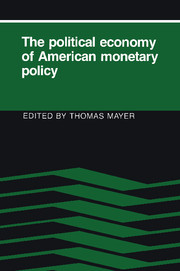Book contents
- Frontmatter
- Contents
- Preface
- List of contributors
- 1 Introduction
- 2 Studying the Fed: toward a broader public-choice perspective
- 3 The Federal Reserve reaction function: a specification search
- 4 Corporate profitability as a determinant of restrictive monetary policy: estimates for the postwar United States
- 5 Federal Reserve behavior since 1980: a financial-market perspective
- 6 The Federal Reserve and its institutional environment: a review
- 7 The political economy of monetary policy
- 8 Political monetary cycles
- 9 Congress and the Fed: why the dog does not bark in the night
- 10 The Federal Reserve as a political power
- 11 Monetary policy and political economy: the Federal Reserve and the Bank of Japan
- 12 A positive analysis of the policy-making process at the Federal Reserve
- 13 A theory of FOMC dissent voting with evidence from the time series
- 14 Explaining FOMC members' votes
- 15 Fed behavior and X-efficiency theory: toward a general framework
- 16 Minimizing regret: cognitive dissonance as an explanation of FOMC behavior
- 17 The discount window
- 18 Leaning against the wind: the behavior of the money stock in recession and recovery, 1953–8
- 19 Bureaucratic self-interest as an obstacle to monetary reform
- Index
14 - Explaining FOMC members' votes
Published online by Cambridge University Press: 06 July 2010
- Frontmatter
- Contents
- Preface
- List of contributors
- 1 Introduction
- 2 Studying the Fed: toward a broader public-choice perspective
- 3 The Federal Reserve reaction function: a specification search
- 4 Corporate profitability as a determinant of restrictive monetary policy: estimates for the postwar United States
- 5 Federal Reserve behavior since 1980: a financial-market perspective
- 6 The Federal Reserve and its institutional environment: a review
- 7 The political economy of monetary policy
- 8 Political monetary cycles
- 9 Congress and the Fed: why the dog does not bark in the night
- 10 The Federal Reserve as a political power
- 11 Monetary policy and political economy: the Federal Reserve and the Bank of Japan
- 12 A positive analysis of the policy-making process at the Federal Reserve
- 13 A theory of FOMC dissent voting with evidence from the time series
- 14 Explaining FOMC members' votes
- 15 Fed behavior and X-efficiency theory: toward a general framework
- 16 Minimizing regret: cognitive dissonance as an explanation of FOMC behavior
- 17 The discount window
- 18 Leaning against the wind: the behavior of the money stock in recession and recovery, 1953–8
- 19 Bureaucratic self-interest as an obstacle to monetary reform
- Index
Summary
The controversy over the effectiveness of monetary policy has raged on for decades despite the fact that the first link in the monetary policy chain has been virtually ignored – the link between the individuals who compose the FOMC and the resulting open-market policy directive. The sixth edition of The Federal Reserve System: Purposes and Functions (1974, p. 57) describes FOMC members as first having to “individually interpret the available statistical and qualitative macroeconomic data in order to evaluate the state of the economy.” Second, “each attending FOMC member is asked to give his or her own policy recommendation.” Finally, “committee members have to deliberate in order to reach a consensus of their individual viewpoints.” The purpose of this chapter is to incorporate this discretionary behavior into an analysis of the voting records of individual FOMC members. The hypothesis to be tested is that FOMC members attempt to implement their personal preferences subject to certain imposed constraints. Career and social-background variables will reflect preferences, whereas relevant political and economic variables will enter as effective constraints.
Preferences: political voting theory
Political scientists have long tried to explain the voting behavior of Supreme Court justices. The question they have tried to answer is this: Why do various Supreme Court justices vote differently when confronted by the same facts and the same history of legal precedents? That question is strikingly similar to the question of interest in this chapter: Why do FOMC members vote differently when confronted by the same economic data and the same economic history?
- Type
- Chapter
- Information
- The Political Economy of American Monetary Policy , pp. 209 - 226Publisher: Cambridge University PressPrint publication year: 1990
- 12
- Cited by



